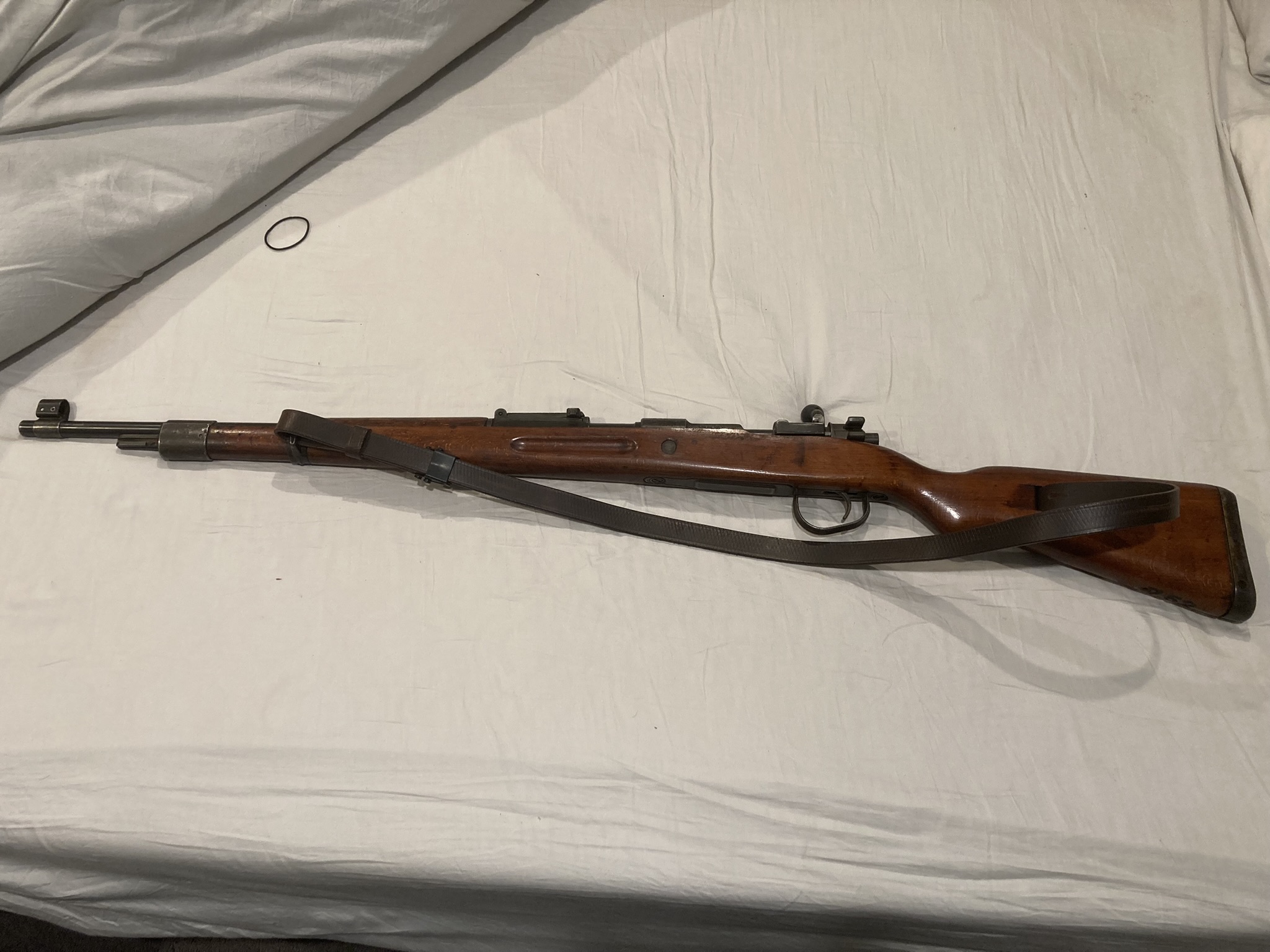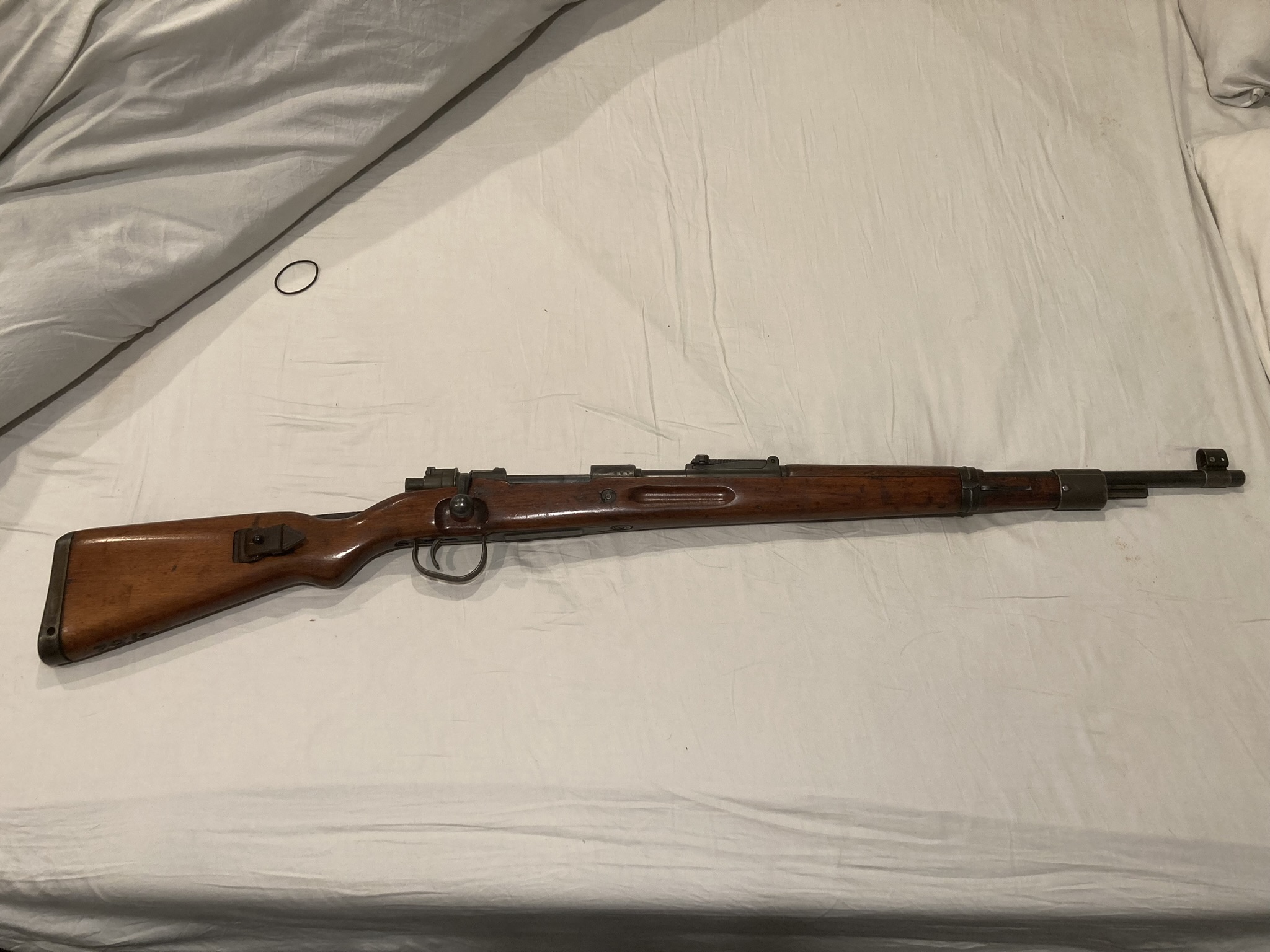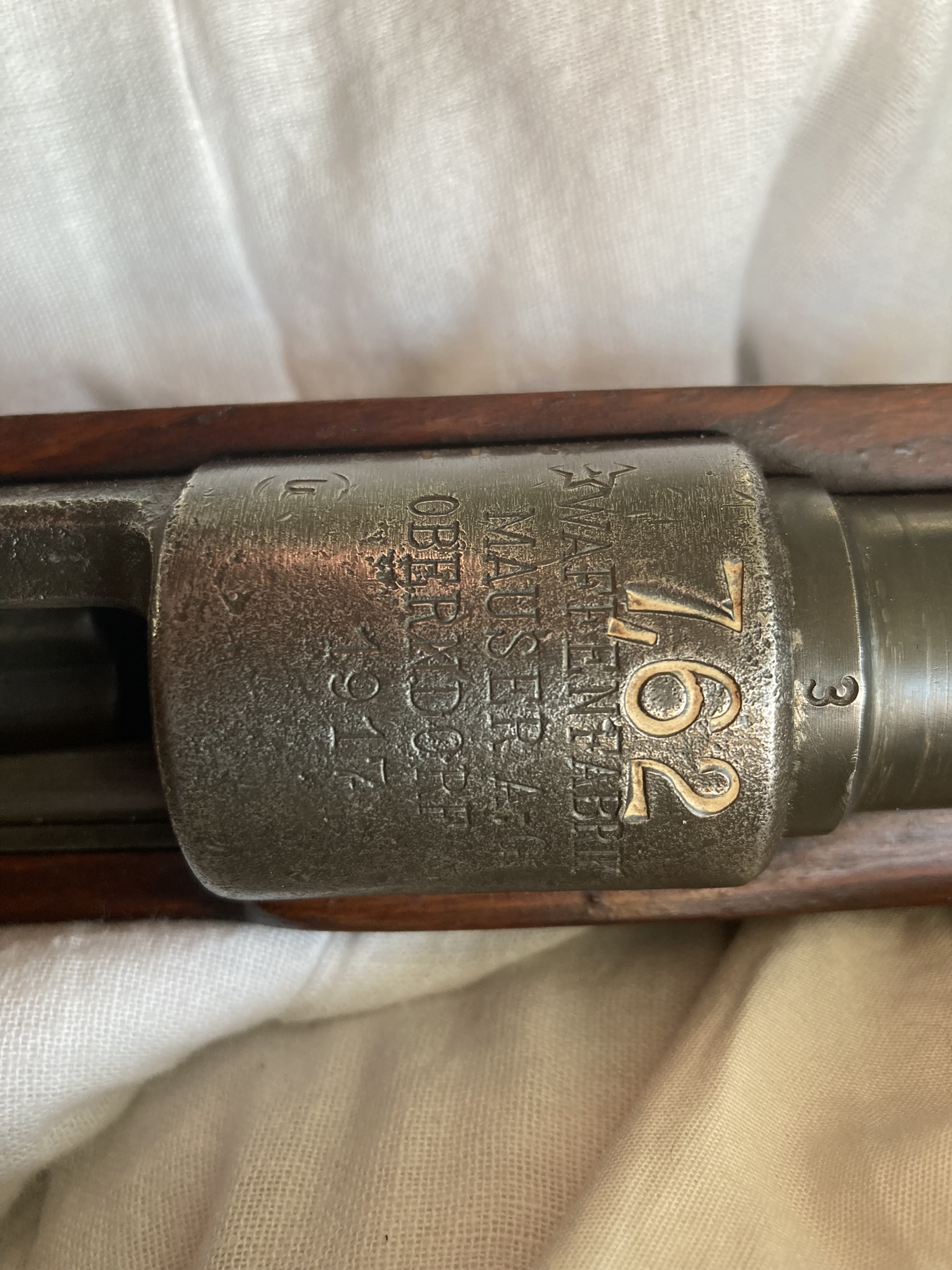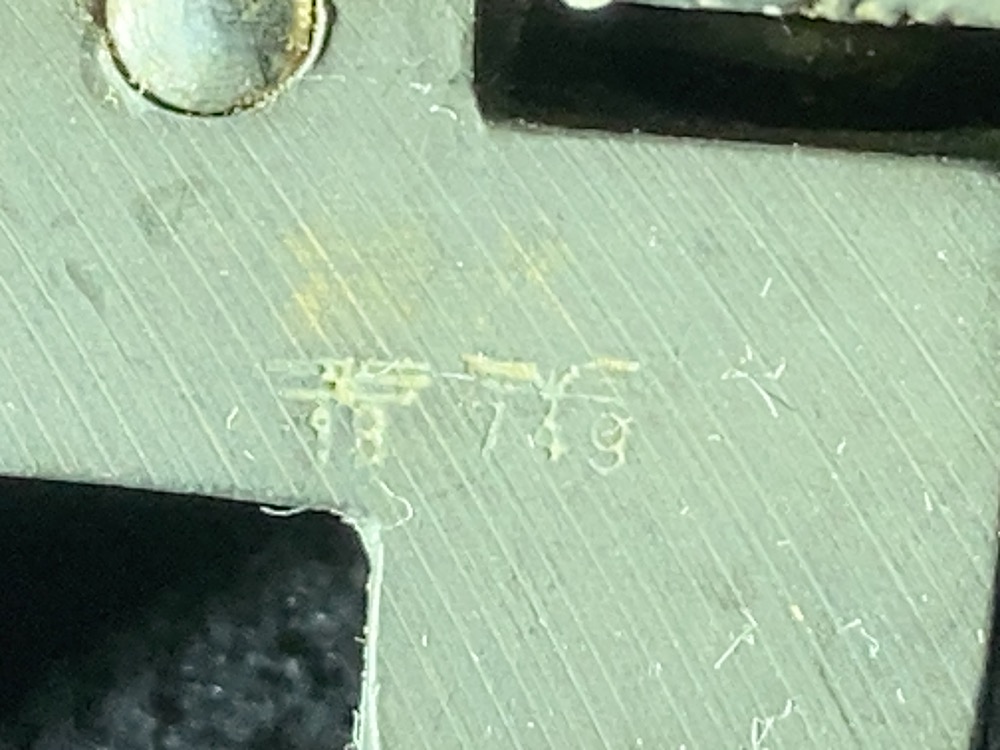After recently catching some sort of milsurp appreciation bug I happened upon what I consider one of the ultimate milsurps. I thought I would share some (admittedly speculative but somewhat informed) history of this rifle.
The receiver of this rifle began life as a Gewehr 98 which was the standard issue german WW1 rifle. It was made in the Mauser factory in Oberndorf in 1917, this is the factory Paul Mauser himself worked in. Most likely this Gew 98 was sent to Turkey for the Ottomans to use against the British/french allies. The receiver does not have a turkish stamp but I have heard not all of them did and I still think this is the most likely way in which the original rifle ended up in the Palestine region. In 1915-1918 British, French and Italian troops invaded Palestine (at that time was under the Ottoman Empire) via Gaza after the Ottomans tried to capture the Suez canal. Eventually the Allies managed to capture Palestine, up to the area that is now southern Syria. During the fighting, it is likely the Gew 98 that makes up this rifle was captured from the Ottomans as they were slowly pushed back.
Since the late 1800s more Jews were immigrating to the Palestine region, fleeing persecution in eastern europe or just to return to what they consider their ancestral homeland. The Palestine region was the kingdom of Israel around 1200 BC, Jews were gradually pushed out of the area after the conquests of the Assyrians, then the Babylonians, then Romans and the Islamic armies. As more Jews immigrated to the area, the local Arab population began to feel their culture and land was threatened by the high immigration. Small skirmishes broke out between Jewish settlers and local Arabs. The Jews felt the need to begin arming themselves with whatever they could get their hands on. These were most likely left over rifles from the English, French and Ottoman armies. This is most likely the point when the captured Gew 98 ended up in the hands of Jewish settlers.
After WW1 ended Britain was in control of the Palestine region. The British had promised Arab independence in the land to get support of the Arab armies in their invasion of palestine. They had also written in support of a homeland for the Jewish people in the area through the Balfour declaration to get support from wealthy Jews toward the war effort. Between WW1 and WW2 more Jewish settlers started coming to Palestine as things were not looking good for Jews in Europe. This caused more protests from the local Arab populations and Britain put limitations on Jewish immigration. They also had the problem of trying to police increasing violence between Jews and Arabs in the region. Around this time a Jewish militia called Haganah was formed. The Gew 98 rifle was most likely one of their rifles. As the danger to Jews in Europe increased, disagreements between local Jews and the occupying British forces also resulted in violence between Haganah and the British. The British put a blockade on weapons imports to Haganah. As WW2 came to a close there was vastly increased pressure from Jewish immigration to the region. Among increasing unrest and violence, Haganah became increasingly desperate for weapons and they found an unlikely ally with the Soviet Union. Stalin, was keen to lend support to a Jewish state as they were at the time not particularly friendly with the British (mutual enemies). Stalin arranged for captured German K98s to be smuggled into Palestine via Czechoslovakia. Haganah ended up with around 4500 ex nazi rifles smuggled in past British security.
The UN then came up with a proposed partition plan for Palestine. The Arabs would have the west bank, Gaza, and all of Jordan while the Jews would have the rest for an independent Jewish state. The Jews agreed to the partition plan and the state of Israel was formed in 1948. Because more land was assigned to Israel relative to their population, the Arabs rejected the plan and declared war on the newly formed state of Israel. The next day Jordan, Egypt, Iraq, Syria, Lebanon, Saudi Arabia and Yemen began fighting the Israelis. Due to the arms imbargo the Jews were not particularly well armed but many Jewish ex WW2 soldiers had immigrated to Palestine so the army was reasonably well organised and combat experienced. The Gew 98 rifle was probably used in the 1948 war in its original configuration. The newly formed IDF was armed with a mix of weaponry, mostly ex Nazi K98s but also Lee Enfields and the odd Gew 98. Against the odds Israel managed to hold off the surrounding Arab nations and captured more land than was promised to them in the UN partition plan. Jordan managed to keep control of the west bank and Egypt managed to keep control of Gaza. The Palestinian locals either voluntarily fled the conflict, were forced away by the Arab armies (under the impression they would return) or Israeli defense force (IDF). The displaced Palestinians were not allowed to return to the areas that were now under Israeli control.
Israel could now legally import weapons and began receiving FN made k98 mausers from Belgium and imported more 8x57 mauser ammunition. Around 1956 Israel began replacing the k98 mausers with automatic FN FAL rifles that ran the 7.62x51 NATO round. The k98 rifles were still the primary IDF rifle at this time and it was decided to convert all the k98 mausers to 7.62 NATO to standardise. Israel managed to purchase tooling from europe to make their own k98 mausers, due to delays this tooling ended up only being used to make spare parts for their current mausers. Around 1956 the program to rebarrel all k98s began. The old k98s were stripped down into parts and reassembled with new 7.62 NATO barrels. The Gew98 that makes up my rifle was likely stripped down and the receiver was rebarrelled. The stock was replaced with an Israeli made k98 stock, the trigger was replaced with Israeli made parts. The sights, some trigger parts and bolt were replaced with parts from ex Nazi guns. These parts are marked with Third riech era straight wing eagle proof stamps. The star of David and Hebrew proof stamp were added to the receiver next to the german imperial eagle proof mark. A large 7.62 was stamped on the reciever and burned into the stock to differentiate it from the mausers that were still barreled in 8x57. It was then likely returned to service in time to fight in the Suez crisis.
In 1967 the surrounding Arab nations were gearing up to fight Israel again. At this time the Soviets had switched sides and were arming the Arab nations so they were well armed with Soviet weapons. Israel decided to launch a preemptive attack, the Israeli airforce took out most of the Egyptian air force and destroyed much of the Egyptian equipment at the Israel border that was being prepared for an invasion. The war which lasted six days was called in the six-day war. In this time Israel managed to seize the whole Sinai peninsula and Gaza from Egypt, the west bank from Jordan and the Golan heights from Syria. The Sinai peninsula was later returned to Egypt as part of a peace treaty. This Israeli mauser was likely involved in this conflict. The FAL was the primary weapon of the IDF at this time but the k98s were still widely used in non-frontline activities.
The Yom Kippur war began on 6 October 1973, when the Arab coalition jointly launched a surprise attack against Israel on the Jewish holy day of Yom Kippur. This was the last conflict that the k98 mausers were involved in and again they would have armed non-front line military personnel. In the 70s the k98 Mausers were retired and many were shipped of to the Guatemala Military, some were imported into the US and my one somehow made it to New Zealand.
In my eyes it is one of the ultimate milsurps, there are parts that have seen WW1, WW2, the 1948 war, and it possibly saw the Suez crisis, Six Day war and Yom Kippur war as a complete rifle. Not too many rifles have seen so much action over such a long period that I am aware of. Also the incredible irony that it is basically the same rifle used against the Jews previously as part of the 'Final Solution'.
The bore is still in good condition and it seems to shoot quite well. I have been playing around with some reduced .308 hand loads and seems like it can group around 2" at 100m which I am more than happy with.

Welcome guest, is this your first visit? Create Account now to join.
Welcome to the NZ Hunting and Shooting Forums.
Search Forums
User Tag List
+ Reply to Thread
Results 1 to 3 of 3
Thread: My New G98/K98 Israeli Mauser
Hybrid View
-
26-06-2024, 10:32 PM #1Member

- Join Date
- Apr 2022
- Location
- Christchurch
- Posts
- 212
My New G98/K98 Israeli Mauser
-
27-06-2024, 05:19 AM #2Member

- Join Date
- Dec 2022
- Location
- Whanganui
- Posts
- 1,335
Nice little read.
-
28-07-2024, 09:07 AM #3Member

- Join Date
- Jul 2024
- Location
- Auckland
- Posts
- 5
Very cool read.
If that rifle could talk!
Tags for this Thread
Welcome to NZ Hunting and Shooting Forums! We see you're new here, or arn't logged in. Create an account, and Login for full access including our FREE BUY and SELL section Register NOW!!





 13Likes
13Likes
 LinkBack URL
LinkBack URL About LinkBacks
About LinkBacks







 Reply With Quote
Reply With Quote


Bookmarks